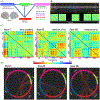Dynamics of Top-Down Control and Motor Networks in Parkinson's Disease
- PMID: 33404161
- PMCID: PMC8373438
- DOI: 10.1002/mds.28461
Dynamics of Top-Down Control and Motor Networks in Parkinson's Disease
Abstract
Background: Motor symptoms in Parkinson's disease (PD) patients might be related to high-level task-control deficits. We aimed at investigating the dynamics between sensorimotor network and top-down control networks (frontal-parietal, cingulo-opercular, and cerebellar) in PD and at determining the effects of levodopa on the dynamics of these networks.
Methods: We investigated dynamic functional connectivity (dFC), during resting state functional magnetic resonance imaging, between sensorimotor network and top-down control networks in 36 PD patients (OFF medication, PD-OFF) and 36 healthy volunteers. We further assessed the effect of medication on dFC in18 PD patients who were also scanned ON medication.
Results: The dFC analyses identified three discrete states: State I (35.68%) characterized by connections between the cerebellum and sensorimotor network, State II (34.17%) with connections between the sensorimotor and frontal-parietal network, and State III (30.15%) with connection between the sensorimotor and cingulo-opercular network. PD patients have significantly fewer occurrences and overall spent less time (shorter dwell time) in State II compared to healthy controls. After levodopa intake, dwell time improved toward normal. The change in dwell time before and after taking levodopa was negatively related to the respective changes in Unified Parkinson's Disease Rating Scale, Part III. PD-OFF showed significantly decreased connectivity between sensorimotor and control networks and increased connectivity within control networks. These changes were partially improved after levodopa intake.
Conclusions: Dopamine depletion in PD is associated with abnormalities in temporal and spatial properties between cognitive control and sensorimotor network, possibly contributing to clinical deficits. Levodopa partially restores the network function toward the values observed in healthy volunteers. © 2021 International Parkinson and Movement Disorder Society.
Keywords: Parkinson's disease; dopamine; dynamic functional connectivity; motor network; top-down control networks.
© 2021 International Parkinson and Movement Disorder Society.
Conflict of interest statement
Competing Interests
The authors report no competing interests.
Figures




References
-
- Esposito F, Tessitore A, Giordano A, et al.Rhythm-specific modulation of the sensorimotor network in drug-naive patients with Parkinson’s disease by levodopa. Brain 2013;136(Pt 3):710–725. - PubMed
-
- Siegert RJ, Harper DN, Cameron FB, Abernethy D. Self-initiated versus externally cued reaction times in Parkinson’s disease. J Clin Exp Neuropsychol 2002;24(2):146–153. - PubMed
-
- Bond JM, Morris M. Goal-directed secondary motor tasks: their effects on gait in subjects with Parkinson disease. Arch Phys Med Rehabil 2000;81(1):110–116. - PubMed
-
- Walton CC, Shine JM, Mowszowski L, et al.Impaired cognitive control in Parkinson’s disease patients with freezing of gait in response to cognitive load. J Neural Transm (Vienna) 2015;122(5): 653–660. - PubMed
Publication types
MeSH terms
Substances
Grants and funding
LinkOut - more resources
Full Text Sources
Other Literature Sources
Medical
Miscellaneous

